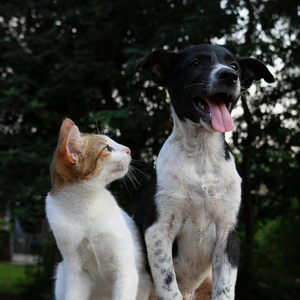The decision to include pet insurance coverage in your monthly budget can be a tough one to make in this time of economic uncertainty. Yet, having pet insurance coverage can give you peace of mind and save you thousands of dollars if your family pet were to become sick or injured. Sadly, many pet owners are forced to make heartbreaking decisions each day when faced with an unexpected emergency vet visit for which they cannot pay. In fact, 31% of dog owners say they can’t afford up to $2,000 in vet bills, even if the treatment could extend or potentially save the dog’s life. How would you handle a large veterinary bill if something happened to your pet?
Pet Insurance Can Save You Money
With the continually rising cost of care, it is worth considering a pet insurance policy. Even if you believe you have enough money to cover veterinary costs, pet insurance could still save you thousands of dollars if your pet gets sick or injured. Especially if you have multiple family pets, your out-of-pocket costs could add up considerably without insurance.
How Does Pet Insurance Work?
Like other types of health insurance, pet insurance can be purchased to transfer the risk of unexpected and unanticipated medical expenses that could be very expensive for the certainty of a fixed monthly premium.
The monthly cost of pet insurance could be around $45 for your dog and $25 for your cats but these rates vary depending on:
- The age and breed of your pet
- The state in which you live (some companies may not cover your state)
- The deductible you choose
- The percent of reimbursement offered
- The custom add-on coverages you select
How Do You Choose?
I decided to consider a pet insurance policy for my new cat after the extended and expensive illnesses of my two other aged cats. I thought choosing a policy would be relatively simple but I was wrong. It seemed that each provider offered different basic and add-on coverages with widely varying rates and I found it difficult to compare one company to the next.
When searching online I found more than a dozen companies to consider. Each company advertises its policy as “the best” but upon reading the fine print I found many hidden pitfalls. I discovered “comparison” sites that offered quick and easy quotes from many companies at once. These comparisons did prove to be helpful but were quite vague about actual coverage. I discovered that many were actually sponsored sites that didn’t honestly select the best choice for my pet but directed me to their sponsoring company. I found it frustrating that no two comparison tools selected the same company for me. Every resource I consulted directed me to a different “best option”.
My head was spinning after hours of research and comparison. I eventually settled on a middle-of-the-road type policy that had good basic coverage for a fair premium. The monthly expense won’t break the bank and I will still have to budget for my basic wellness services and my deductible but I’ll have the $10,000 in coverage in case of an accident or unexpected illness.
I have created a comparison chart containing the information that I was able to collect online from the ten companies that seemed most popular. This was the basic information available at the time I was shopping so I can’t vouch for the current accuracy. This chart is for educational purposes only. Ask Your Animals is not offering insurance advice and is not an insurance expert. Each person utilizing this information is responsible for their insurance choices and due diligence.
Please provide your information below to get the comparison emailed to you.
What Should You Look For When Choosing A Pet Insurance Company?
Although no two companies offer exactly the same coverage, this is a summary of what to expect.
- All plans have a deductible. You can select a level ranging from $250 to $750 annually. The higher the deductible, the lower your premium. Read the fine print to see if they are offering an annual deductible or a “per incident” deductible.
- Reimbursement for covered expenses ranges from 70% to 100%. The higher reimbursement rates will also increase your premium.
- Some companies offer a discount or bonus for your initial sign-up.
- Look carefully for enrollment fees. These can be up to $35 for your first month.
- Most plans have a waiting period before coverage begins. The average was around 14 days. Dog owners beware, there could be up to 12 months wait period for coverage of ACL repair.
- Plans usually carry an annual limit on coverage. This can be a deal breaker. Don’t pay a $20 premium for a policy that will max out at $5,000 when you can get $10,000 coverage for the same price. One visit to the emergency vet clinic can easily exceed $5,000. Some policies offer unlimited annual limits so check the fine print.
- Find out if you are required to take your pet for an annual vet exam in order to keep your policy in force.
- Keep your eyes open for upper age limits on coverage and lifetime maximum limits. Read carefully for the limits such as “annual limit”, “per-incident”, and “lifetime maximum”
- Find out if the policy pays for actual expenses for an illness or if the coverage is limited by a predetermined “benefit schedule” that caps coverage at a fixed price regardless of complications that arise or additional treatments needed to resolve the condition.
- Most companies cover dogs and cats but very few cover exotics or other small animals such as rabbits and birds.
- It would be helpful if insurance were to cover preventive healthcare such as routine dental cleaning but, like human healthcare, they focus on only the illness. An annual dental cleaning is an important part of any pet’s wellness plan and including this can prevent problems down the road. Most companies do not cover routine dental cleaning and some even exclude dental illnesses such as gum disease.
- Most companies will require you to pay your vet for all services upfront and then submit a claim for reimbursement. Only a few policies will reimburse the vet directly.
- A few companies now offer an app that speeds the process of filing claims and offers vet chat services 24/7.
- Narrow down your choices and get a quote specific to your pet’s needs from various providers. Make sure they provide a “Sample Policy” for your state so you can review the fine print before signing.
Most plans will cover:
- Accidental injury
- Surgery
- Diagnosis and treatment of illness
- Chronic disease
- Hereditary or congenital conditions
- Cancer treatment
- Prescription medication
- Dental injury (broken tooth)
Most plans will exclude:
- All plans exclude pre-existing conditions
- Elective procedures including spaying/neutering
- Routine or preventive care
- Wellness exams
- Routine dental cleaning. Some exclude dental diseases
- Pet supplies or supplements
- Prescription food
- Flea and tick treatments
- Vaccinations
- Vet exam fees
- End-of-life expenses including euthanasia
Some policies will offer add-on coverage for:
- Alternative treatments such as acupuncture
- Vet exam fees
- Behavior modification
- Spay/neuter
- Physical therapy and rehab
These policy add-ons can greatly expand coverage, particularly for routine and wellness care. I found that this coverage comes at a very high price. In some cases, the annual add-on premium was even higher than the average out-of-pocket expense it covers. One company’s Optional Wellness Package more than doubled the original monthly premium. Please be careful to evaluate your expected annual out-of-pocket costs and consider putting the money aside in your savings account rather than purchasing the policy add-on.
Read The Fine Print
All companies do a lovely job of presenting a bright and attractive (and sometimes misleading) sales page with a summary of their coverages. None of them engage in full disclosure upfront. Before purchasing any policy, read the sample contract that details all of the conditions, exclusions, and fine print of their contract.
Dog owners should be particularly careful to read the coverage details for hip dysplasia or surgical repair of an ACL tear. Some companies exclude coverage while others require a 12-month wait period for coverage to begin. This surgery can cost up to $7,000 per knee and a double repair would max out your $10K annual limit.
Only a few companies offer coverage for vet exam fees. This can come as a surprise when you receive a vet bill for $300 and $170 of it is the exam fee. Only the remaining $130 would qualify for insurance reimbursement and then only after you have met your deductible.
In Conclusion
Each family needs to evaluate the expected annual costs of keeping their family pets healthy. No two families have the same needs. Choose a plan that balances the coverage you need with the cost of the premium. Make a budget to cover not only your premiums but the other routine out-of-pocket expenses such as annual vaccines, fleas and tick preventative, dental care, vet exam fees, your annual deductible, and the 10-30% of expenses not covered by your insurance reimbursement.
Ask the front desk staff at your vet’s office to help you by preparing estimates for routine expenses. Planning ahead and following your budget can save you from taking on long-term debt when surprise expenses arise. After all, the joy and love that our pets bring to our lives is priceless




